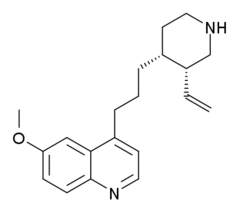Chemistry:Viqualine
From HandWiki
Short description: Medication
 | |
| Identifiers | |
|---|---|
| |
| CAS Number | |
| PubChem CID | |
| ChemSpider | |
| UNII | |
| ChEMBL | |
| Chemical and physical data | |
| Formula | C20H26N2O |
| Molar mass | 310.441 g·mol−1 |
| 3D model (JSmol) | |
| |
| |
| | |
Viqualine (INN) (developmental code name PK-5078) is an antidepressant and anxiolytic drug that was never marketed.[1][2][3] It acts as a potent and selective serotonin releasing agent and serotonin reuptake inhibitor.[3][4] In addition, viqualine displaces diazepam from the GABAA receptor and produces benzodiazepine-like effects, indicating that it is also a positive allosteric modulator of the benzodiazepine site of the GABAA receptor.[3][5] The drug has mainly been researched as a potential treatment for alcoholism.[6][7]
See also
References
- ↑ The Dictionary of Drugs: Chemical Data: Chemical Data, Structures and Bibliographies. Springer. 14 November 2014. pp. 1–. ISBN 978-1-4757-2085-3. https://books.google.com/books?id=0vXTBwAAQBAJ&pg=RA1-PA602.
- ↑ "Viqualine in resistant depression: a double-blind, placebo-controlled trial". Neuropsychobiology 20 (2): 78–81. 1988. doi:10.1159/000118477. PMID 3075725.
- ↑ 3.0 3.1 3.2 Pharmacotherapy for Depression and Treatment-resistant Depression. World Scientific. 2010. pp. 304–. ISBN 978-981-4287-59-3. https://books.google.com/books?id=zigp-66vq0MC&pg=PA304.
- ↑ "The 5-hydroxytryptamine-releasing properties of two epimer quinoline derivatives". Neuropharmacology 23 (2A): 169–173. February 1984. doi:10.1016/S0028-3908(84)80010-6. PMID 6717757.
- ↑ "Viqualine in resistant depression: a double-blind, placebo-controlled trial". Neuropsychobiology 20 (2): 78–81. 1988. doi:10.1159/000118477. PMID 3075725.
- ↑ "Serotonin Uptake Inhibitors Attenuate Ethanol Intake in Problem Drinkers". Recent Developments in Alcoholism. 7. 1989. pp. 255–266. doi:10.1007/978-1-4899-1678-5_13. ISBN 978-1-4899-1680-8.
- ↑ "Differential effects of viqualine on alcohol intake and other consummatory behaviors". Clinical Pharmacology and Therapeutics 46 (3): 301–309. September 1989. doi:10.1038/clpt.1989.142. PMID 2673621.
 |
